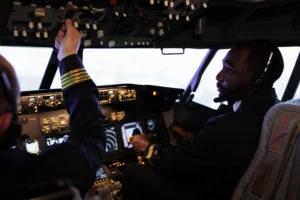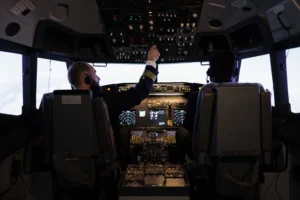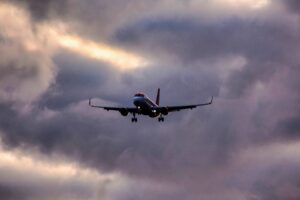Pilot training is a great experience that allows obtaining the necessary skills and becoming a successful specialist. It’s that buzz of being in the air, that sense of liberation that one cannot describe. But being a pilot requires learning and hard work to be able to manage a plane and take it to the skies. To become a student pilot, you are going to face a lot of challenges and of course, commit some errors.
But don’t worry! It is important to note that it is normal for people to make mistakes when they are learning. You need to be aware of these pitfalls in order not to fall into them, and eventually progress and become an assured pilot. In this article, we will tell you about ten common mistakes that student pilots make and provide practical tips on how to avoid them.
Whether you’re just starting your flight training or looking to polish your skills, this guide will help you navigate the skies more safely and effectively. Let’s dive in!
Neglecting Ground School Studies
Mistake:
This is a problem in which most student pilots find themselves in a situation whereby they tend to prioritize their flight training to the extent that they forget about ground school practice. The following can culminate in poor comprehension of important facets such as aerodynamics, weather, navigation, and regulations.
How to Avoid:
As much as you consider flight training important, do the same as ground school training. Stick to a regimen of studying and reviewing the material, use books, online courses, and study groups, and engage in class. Knowing the theory behind operations will strengthen your flying acts, and you will be set for a written test.
Poor Pre-Flight Planning

Mistake:
There are so many areas that can go wrong if pre-flight planning is done poorly; navigation issues, wrong fuel estimates, and weather issues among others.
How to Avoid:
The pre-flight planning needs to become a complex and well-developed procedure. This should comprise checking the weather, estimating fuel needed, studying NOTAMs, and routing with contingency aerodromes. Some of them include; Flight planning software and applications to aid in this process. Consult with your instructor and see if there are any major areas that you have left out in your plan.
Inadequate Communication Skills
Mistake:
One of the main problems that students often have to face during their practice is difficulties with radio communication. Disorientation of positions may result in confusion with the ATC as well as with other planes in the vicinity, thus leading to certain hazards.
How to Avoid:
Practice is key. Old videos and the Live ATC app are some of the ways through which one can listen to ATC communications. In speaking, do so clearly and concisely. Practice with your instructor to mimic the circumstances that can be encountered in the course of radio communication. Always make sure that you are aware of common phrases and protocols as this will increase your confidence and efficiency.
Mismanaging Cockpit Workload

Mistake:
Some features of the Cockpit environment are that it is stressful and challenging to manage especially when dealing with an unexpected environment. Inadequate workload management makes one miss vital duties or do them incorrectly.
How to Avoid:
You should be able to understand how to schedule your time properly by being able to know how to arrange your priorities. Always remember to use the checklists so that there can be no single step that is not checked on. This way, you develop your multitasking ability and it helps you practice flying under different conditions. Subdivide a task into the constitutive elements to simplify it. For sequences and procedures, most of which are sequential, the use of mnemonic devices of the successive items in a sequence is recommended.
Lack of Confidence or Overconfidence
Mistake:
If one is too confident, he or she may take undeserving chances, whereas if one has low self-confidence, he or she holds back for what they believe is the ‘perfect’ chance.
How to Avoid:
Maintain a balanced mindset. Admit when you do not or cannot know something, and be eager to learn and counsel at all times. Discuss with your instructor, how you are doing and establish achievable goals in the course. People need to gain confidence by practicing and being prepared; however, people need to remember how dangerous and complicated flying is.
Ignoring Weather Condition

Mistake:
By not considering weather conditions, one can easily get into harm’s way. Weather is also very dynamic and any failure in considering this aspect can lead to the emergence of catastrophes.
How to Avoid:
Acquire mastery of the subject matter, meteorology. Ensure to check for the weather and its changes before and during the flights. Know how to analyze weather maps and radar pictures. Here are the things a pilot has to know about how various weather conditions impact his or her aircraft and flight. Be more cautious on weather-related choices and never doubt to scratch a flight or even ground an entire airline if the weather will not cooperate.
Also Read: Role Of Weather In Aviation
Improper aircraft handling
Mistake:
Some common types are; Flight control errors concerning flights, knowledge errors concerning aircraft systems, and errors made during take-off, landing, and in emergency conditions.
How to Avoid:
Possible advice to follow is to spend a lot of time both in the simulator and with the instructor to enhance the knowledge of the basic aspects of aircraft control. Listen to instructions from the flight instructor and make inquiries where you are in doubt. Repetition of the practice is very important, and one should continue doing the maneuvers until that comes naturally. Become familiar with aircraft systems, and establish what should be done in different circumstances.
Inadequate Situational Awareness
Mistake:
Lack of this situational awareness results in airspace infringements, arrival at controlled airspace from an unlocked position, and loss of control.
How to Avoid:
Always look around and at other traffic, the road, and the conditions and environment that you are in. All tools available in this generation and the former ones such as GPS, ADS-B, and even the VFR visual references must always be utilized. This way, control your mental image and always stay vigilant about your position concerning the navigation aids or the waypoints. Learn to check around often to familiarize yourself with other planes and dangers that may be there.
Neglecting Checklist Usage
Mistake:
Sometimes, people develop a tendency to skip such checklists or simply fail to spend ample time going through them, and at this juncture, important steps may be omitted which leads to unsafe flight conditions.
How to Avoid:
Use checklists even when it feels unnecessary to do so. Track them strictly: do not hurry them. The participants should explain why each of the items on the checklist is relevant to what needs to be done and why some of the steps might have been omitted. Always use the checklists irrespective of how experienced you may perhaps be in that certain airplane or that inflexible procedure.
Failure to learn from mistakes
Mistake:
Failing to make corrections can mean repeating the same mistakes over time, which is counterproductive and detrimental to the pilot’s development.
How to Avoid:
Always discuss with your instructor after each flight what went well or bad and what corrections you can make. Maintain a diary of personal errors and things that one needs to learn. Actively look for feedback and of course always welcome criticisms. Utilize errors as best as possible and learn from the experience. It is expected that diamonds are lifelong learners meaning they should continue with their learning and enhancement right from the time they start training up to the time they retire.
Conclusion
In conclusion, dedication, practice, and being prepared to learn lessons from achievements and mistakes are necessary to become a skilled pilot. By being aware of these common mistakes and actively working to avoid them, student pilots can enhance their training experience and build a solid foundation for a successful aviation career. Remember, every pilot, regardless of experience level, is always learning. Remain modest, remain to ask, and fly safely.
FAQ
What should I do if I feel overwhelmed during my training?
Feeling overwhelmed is normal during flight training. Step back and consider the things that are stressing you out. Communicate with your instructor about your concerns; they can provide guidance and adjust the training pace if needed. Break down your learning into smaller, manageable chunks, and focus on mastering one skill at a time. Remind yourself to take breaks and give yourself a moment to rest and recover.
How can I ensure I’m prepared for my check ride?
You must prepare for your check ride from the first day of your training. Regularly review the ACS (Airman Certification Standards) to understand the requirements. Practice each maneuver and procedure until you can perform them confidently. With your teacher, go on mock check-ride scenarios to replicate the real exam setting. Ensure all your paperwork is in order, and take care of any administrative tasks well in advance.
What resources are available to help me with my flight training?
There are numerous resources available to support your flight training. Use textbooks, online courses, and aviation apps for ground school studies. Join local flying clubs or online forums to connect with fellow student pilots and experienced aviators. Expand your knowledge by attending seminars and workshops. Additionally, simulators and flight planning software can provide valuable practice and enhance your learning experience.
